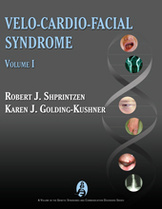Publication

Velo-Cardio-Facial Syndrome, Volume I
- Details:
- 289 pages, Illustrated (B/W), Softcover, 7 x 10"
- Included Media:
- DVD
- ISBN13:
- 978-1-59756-071-9
- Release Date:
- 07/01/2008
Overview
With an estimated human population prevalence of 1:2000, Velo-Cardio-Facial Syndrome (VCFS) is the second-most common multiple anomaly syndrome in humans and almost all children with the syndrome have speech and language impairments that are generally recognized to be complex and difficult to treat.
To demonstrate and to provide clinicians with expert guidance, the authors have produced a comprehensive two-volume set with a combination of text and video demonstrating the clinical features of Velo-Cardio-Facial Syndrome (VCFS); the communication phenotype in VCFS; the natural history of speech and language in VCFS; diagnostic procedures necessary for assessing speech and language disorders in VCFS; the treatment of speech and language impairment in VCFS; and outcomes, demonstrated by video on an accompanying DVD to Volume II.
This volume commences with a survey of the history of VCFS and provides an exhaustive description of the 190 phenotypes associated with the syndrome, including speech and language, hearing, cognition, and many other critically affected areas. The genetics of VCFS are extensively covered, including inheritance factors and an exploration of the genome deletion. Thereafter, a range of triage options across a wide variety of medical and allied health disciplines is given, before concluding with a final chapter on growth, weight gain, and feeding. An accompanying DVD includes 19 video clips with examples to illuminate the accompanying chapter matter.
- Preface
- Chapter 1: The History of VCFS
- The History of VCFS
- Two Major Events in 1992
- Communication Disorders and VCFS
The Significance of Two Anomalies Occurring Together
The Implications for Speech Pathologists, Surgeons, and Other Craniofacial Specialties - What Do I Call It?
- Chapter 2: The Expansive Phenotype of VCFS
- Craniofacial Anomalies
- Ear and Hearing Anomalies
- The Nose
- Eye Findings
- Cardiac Findings
- Vascular Anomalies
- Brain and Central Nervous System Anomalies
- Pharyngeal, Laryngeal, and Airway Anomalies
- Abdominal and Visceral Anomalies
- Limb Anomalies
- Problems in Infancy
- Genitourinary Anomalies
- Skeletal, Muscle, Spine, and Orthopedic Anomalies
- Skin and Hair Findings
- Endocrine and Immune Findings
- Speech and Language Disorders
- Cognitive, Learning, and Attentional Disorders
- Psychiatric Disorders
- Miscellaneous Anomalies
- Secondary Developmental Sequences
- Why the Expansive Phenotype ?
- Chapter 3: The Genetics of VCFS
- What Does Genetic Mean?
Mode of Inheritance - Describing the Genome at 22q11.2
Determining the Nature of the Deletion in VCFS
How the Deletion Occurs
Identifying the Genes in the Deleted Region
Determining What the Genes Do, Identifying
Candidate Genes for Specific Phenotypes, and Identifying Polymorphisms
Animal Models and Knockouts
How Is a Deletion Different from Other Mutations? - Genetic Effects Outside of the 22q11.2 Region That Contribute to the Phenotype
Epigenetic Factors That Might Contribute to the Phenotypic Spectrum - Genetic Counseling for VCFS
- Mosaicism and Germline Mosaicism
- Counseling for People with VCFS
- What Does Genetic Mean?
- Chapter 4: Triage in VCFS: Utilizing the Natural History
- Audiology (Hearing Testing)
- Cardiology (Pediatric Cardiology)
- Cardiothoracic Surgery
- Clinical Genetics and Genetic Counseling
- Dentistry and Orthodontics
- Developmental Pediatrics
- Endocrine Evaluation
- Gastroenterology (Pediatric Gastroenterology)
- Immunology Evaluation
- Magnetic Resonance Imaging and Angiography
- Nasopharyngoscopy, FEES or FEESST, Direct Laryngoscopy, Bronchoscopy, Esophagoscopy, and Gastroscopy
- Nephrology
- Neurology
- Neuropsychology
- Neurosurgical Evaluation
- Nutrition
- Ophthalmology (Pediatric Ophthalmology)
- Orthopedics
- Otolaryngology
- Physical Therapy
- Podiatry
- Psychiatry
- Pulmonology (Pediatric Pulmonology)
- Reconstructive Surgery
- Renal Ultrasound
- Speech-Language Evaluation
- Urology
- Videofluoroscopy for Speech
- Videofluoroscopy for Swallowing
- Chapter 5: Growth, Weight Gain, and Feeding
- Is Short Stature a Feature of VCFS?
- Significance of these Data and the Growth Curve
- Possible Flaws in the Data
- Implications
- Feeding Therapy
Emesis and Spitting Up Through the Nose
Feeding Time (Duration)
Feeding Position
Type of Bottle and Nipple
Burping - Identifying and Understanding the Factors Leading to Problems
- What If the Child Already Has a Tube?
- Appendix: Clinical Synopsis of VCFS
- Index
About The Authors
A founding member of the Velo-Cardio-Facial Syndrome Educational Foundation, Inc. and its first Executive Director, Dr. Shprintzen is Director of several programs at the State University of New York Upstate Medical University in Syracuse, New York, including the Communication Disorder Unit, the Velo-Cardio-Facial Syndrome International Center, and the Center for Genetic Communicative Disorders. He is Professor of Otolaryngology and Professor of Pediatrics at Upstate. Widely published and recognized internationally, he is credited for delineating four genetic disorders, including velo-cardio-facial syndrome (also known as Shprintzen syndrome), Shprintzen-Goldberg craniosynostosis syndrome, Shprintzen-Goldberg omphalocele syndrome, and Goldberg-Shprintzen syndrome.
Karen J. Golding-Kushner, PhD, Executive Director of The Velo-Cardio-Facial Syndrome Educational Foundation, Inc.
Related Titles
Group Treatment for Asperger Syndrome
182 pages, Illustrated (B/W), Softcover, 6 x 9"
Medical Genetics
182 pages, Color Illustrations (4 Color), Softcover, 7 x 10"
Velo-Cardio-Facial Syndrome, Volume II
Karen J. Golding-Kushner, Robert J. Shprintzen
256 pages, Illustrated (B/W), Softcover, 7 x 10"
Genetics, Embryology, and Development of Auditory and Vestibular Systems
Sherri M. Jones, Timothy A. Jones
272 pages, Color Illustrations (4 Color), Softcover, 7 x 10"
CHARGE Syndrome
Edited by: Timothy S. Hartshorne, Margaret A. Hefner, Sandra L.H. Davenport, James W. Thelin
408 pages, Color Illustrations (2 Color), Softcover, 7 x 10"
Waardenburg Syndrome
136 pages, Color Illustrations (4 Color), Softcover, 7 x 10"
Here's How to Provide Intervention for Children with Autism Spectrum Disorder
Catherine B. Zenko, Michelle Peters Hite
184 pages, Illustrated (B/W), Softcover, 8.5 x 11"
Educating Children with Velo-Cardio-Facial Syndrome (also Known as 22q11.2 Deletion Syndrome and DiGeorge Syndrome)
328 pages, Illustrated (B/W), Softcover, 7 x 10"
Evaluation and Management of Cleft Lip and Palate
David J. Zajac, Linda D. Vallino
418 pages, Color Illustrations (4 Color), Softcover, 7 x 10"


















